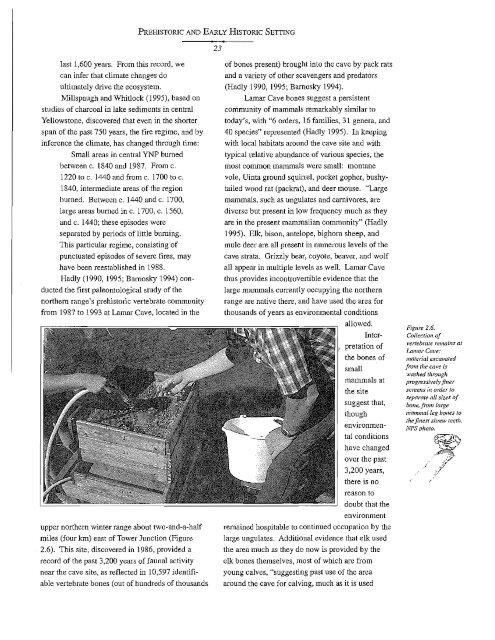Yellowstone's Northern Range - Greater Yellowstone Science ...
Yellowstone's Northern Range - Greater Yellowstone Science ...
Yellowstone's Northern Range - Greater Yellowstone Science ...
Create successful ePaper yourself
Turn your PDF publications into a flip-book with our unique Google optimized e-Paper software.
PREHISTORIC AND EARLY HISTORIC SETTING<br />
23<br />
last 1,600 years. From this record, we<br />
can infer that climate changes do<br />
ultimately drive the ecosystem.<br />
Millspaugh and Whitlock (1995), based on<br />
studies of charcoal in lake sediments in central<br />
<strong>Yellowstone</strong>, discovered that even in the shorter<br />
span of the past 750 years, the fire regime, and by<br />
inference the climate, has changed through time:<br />
Small areas in central YNP burned<br />
between c. 1840 and 1987. From c.<br />
1220 to c. 1440 and from c. 1700 to c.<br />
1840, intermediate areas of the region<br />
burned. Between c. 1440 and c. 1700,<br />
large areas burned in c. 1700, c. 1560,<br />
and c. 1440; these episodes were<br />
separated by periods of little burning.<br />
This particular regime, consisting of<br />
punctuated episodes of severe fires, may<br />
have been reestablished in 1988.<br />
Hadly (1990,1995; Barnosky 1994) conducted<br />
the first paleontological study of the<br />
northern range's prehistoric vertebrate community<br />
from 1987 to 1993 at Lamar Cave, located in the<br />
upper northern winter range about two-and-a-half<br />
miles (four km) east of Tower Junction (Figure<br />
2.6). This site, discovered in 1986, provided a<br />
record of the past 3,200 years of faunal activity<br />
near the cave site, as reflected in 10,597 identifiable<br />
vertebrate bones (out of hundreds of thousands<br />
of bones present) brought into the cave by pack rats<br />
and a variety of other scavengers and predators<br />
(Hadly 1990, 1995; Barnosky 1994).<br />
Lamar Cave bones suggest a persistent<br />
community of mammals remarkably similar to<br />
today's, with "6 orders, 16 families, 31 genera, and<br />
40 species" represented (Hadly 1995). In keeping<br />
with local habitats around the cave site and with<br />
typical relative abundance of various species, the<br />
most common mammals were small: montane<br />
vole, Uinta ground squin-el, pocket gopher, bushytailed<br />
wood rat (packrat), and deer mouse. "Large<br />
mammals, such as ungulates and carnivores, are<br />
diverse but present in low frequency much as they<br />
are in the present mammalian community" (Hadly<br />
1995). Elk, bison, antelope, bighorn sheep, and<br />
mule deer are all present in numerous levels of the<br />
cave strata. Grizzly bear, coyote, beaver, and wolf<br />
all appear in multiple levels as well. Lamar Cave<br />
thus provides incontrovertible evidence that the<br />
large mammals currently occupying the northern<br />
range are native there, and have used the area for<br />
thousands of years as environmental conditions<br />
allowed.<br />
Interpretation<br />
of<br />
the bones of<br />
small<br />
mammals at<br />
the site<br />
suggest that,<br />
though<br />
environmental<br />
conditions<br />
have changed<br />
over the past<br />
3,200 years,<br />
there is no<br />
reason to<br />
doubt that the<br />
environment<br />
remained hospitable to continued occupation by the<br />
large ungulates. Additional evidence that elk used<br />
the area much as they do now is provided by the<br />
elk bones themselves, most of which are from<br />
young calves, "suggesting past use of the area<br />
around the cave for calving, much as it is used<br />
Figure 2.6.<br />
Collection of<br />
vertebrate remains at<br />
Lamar Cave:<br />
material excavated<br />
from the cave is<br />
washed through<br />
progressively filler<br />
screens in ordet to<br />
separate all sizes of<br />
bone, from large<br />
mammal leg bOlles to<br />
thefillest shrew teeth.<br />
NPS photo.<br />
f~j",<br />
'{:~"';;<br />
.~~<br />
,/<br />
;Y















